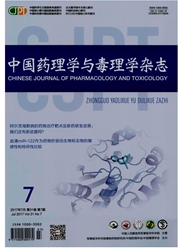

 中文摘要:
中文摘要:
靶向细胞凋亡是目前癌症治疗中最具发展前景的治疗方法之一。BCL-2家族的BH3-only蛋白(仅含BCL-2同源结构域BH3)可以通过与家族中促存活蛋白结合,使促存活蛋白失效,从而使促凋亡成员发挥作用,最终导致细胞发生程序性凋亡。BH3类似物即一类可以模仿BH3-only蛋白并诱发细胞凋亡的小分子化合物。BH3类似物的原型ABT-737可以选择性靶向BCL-XL、BCL-2和BCL-W 3个促存活蛋白(但不能作用于髓细胞白血病因子-1蛋白或A1蛋白),而它的衍生物ABT-263(navitoclax)在临床试验中有显著的促凋亡与抗肿瘤效应。现阶段,一些推测为BH3类似物的药物已经进入了临床阶段,但很大一部分仍在进行特征鉴定。本文在概述BH3-only蛋白作用机制的基础上,综述了多种已经广泛认可的BH3类似物及正在研究当中的最新BH3类似物。
 英文摘要:
英文摘要:
Targeting cell apoptosis is currently the most promising therapy for cancer treatment.The BH3-only protein, which is a member of Bcl-2 family, can bind to the pro-survival members of the family and neutralize their functional activities to induce apoptosis(ie, to isolate pro-apoptotic members of the Bcl-2 family). BH3 mimetics, a kind of small molecule compounds, has the ability to mimic the BH3-only protein to induce apoptosis. The prototype of BH3 mimetics is ABT-737, who can selectively targets on BCL-XL, BCL-2 and BCL-W(but not MCL-1 and A1). ABT-263, a derivative of ABT-737, has a better performance of inducing apoptosis and inhibiting the growth of tumor in clinical trials. At this stage, some presumably BH3 mimetics has entered the clinical stage, while a large part of them is still being characterized and tested. Basing on the mechanism of BH3-only protein, this review summarize a variety of BH3 mimetics which have been widely recognized, and show the latest developments of newly diagnosed BH3 mimetics in the field.
 同期刊论文项目
同期刊论文项目
 同项目期刊论文
同项目期刊论文
 Genistein accelerates refractory wound healing by suppressing superoxide and FoxO1/iNOS pathway in t
Genistein accelerates refractory wound healing by suppressing superoxide and FoxO1/iNOS pathway in t Hypoxia-Inducible Factor 1-alpha Dependent Pathways Mediate the Renoprotective Role of Acetazolamide
Hypoxia-Inducible Factor 1-alpha Dependent Pathways Mediate the Renoprotective Role of Acetazolamide The effect of topiramate on tumor-related angiogenesis and on the serum proteome of mice bearing Lew
The effect of topiramate on tumor-related angiogenesis and on the serum proteome of mice bearing Lew Layered Signaling Regulatory Networks Analysis of Gene Expression Involved in Malignant Tumorigenesi
Layered Signaling Regulatory Networks Analysis of Gene Expression Involved in Malignant Tumorigenesi Clarifying off-target effects for torcetrapib using network pharmacology and reverse docking approac
Clarifying off-target effects for torcetrapib using network pharmacology and reverse docking approac 期刊信息
期刊信息
